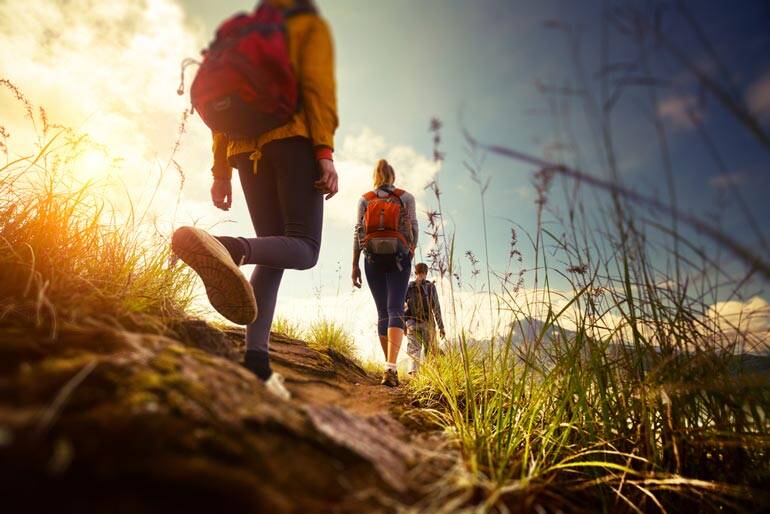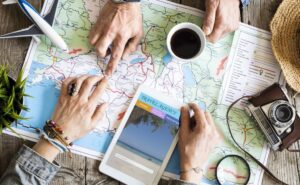Hiking is a great opportunity to see nature and get away from everyday life. It also allows you to reconnect with the natural world. Whether you are an experienced hiker or a novice, hiking can be safer and more enjoyable if you are prepared and know what to expect. This article provides basic walking advice, covering everything from organizing your walk and taking the right equipment to being careful and mindful of the environment.
1. Planning Your Hike
Careful planning is crucial to the success of any hiking tour. Choose a route based on your experience and fitness level. Make sure the route is right for you by researching the length, elevation gain, and difficulty. It’s crucial to know how long it takes to complete a hike so you can plan your day appropriately. It is important to check the weather forecast before heading out. In the mountains or forests, the weather can change quickly, so it is important to be prepared for wind, rain, and extremely high or low temperatures. While hiking, be sure to inform someone of your planned route and expected return time so that he or she can sound the alarm if you do not arrive as planned.
2. Get the Right Equipment
Having the right equipment can greatly improve your hiking experience. Start with a pair of walking boots or shoes that are supportive, increase traction, and are comfortable. Crumble them up before walking to prevent blisters. Dress in layers to adapt to changing weather patterns, and choose materials that wick moisture to keep you dry and comfortable. An organized backpack is essential for a good hike. Even if you know the way, a map, compass, and GPS gadgets are essential. To stay hydrated and energized, bring plenty of water and energy-dense snacks. Your supplies should include a basic first aid kit with bandages, antiseptic wipes, and any personal medications. Don’t forget to wear sunglasses, a hat, and sunscreen for sun protection.
3. Follow the Path
Being able to navigate is critical, especially on trails that are less traveled or poorly marked. Learn to read trail maps and keep a location log while hiking. Pay attention to the markers and signs, and don’t be afraid to return to a familiar location if you’re unsure of the trail. Make sure your smartphone or GPS device is fully charged before use and consider bringing a portable charger.
4. Staying Safe on the Trail
Safety always comes first when walking. To ensure you have enough daylight to complete the hike, start as early as possible. Avoid taking shortcuts, which could cause you to get lost or enter dangerous terrain, and stick to designated paths. When hiking in bear country, be aware of your surroundings and be prepared for any wildlife you encounter. Walking in a group or with friends is safer than walking alone. If you must hike alone, be extra careful and bring extra equipment such as a whistle or personal siren. Pay attention to your body’s signals; if you feel dizzy, tired, or uncomfortable, stop and consider whether you should turn around.
5. Leave No Trace Principles
To preserve the beauty of natural areas and ensure that future hikers can enjoy them, people must respect the environment. Follow Leave No Trace guidelines, including removing litter, following designated routes, and minimizing your impact on the environment. Avoid collecting plants, disturbing wildlife, and leaving trails.
6. Emergency Handling
Even with careful preparation, emergencies can arise. Having the tools to treat minor wounds and knowing basic first aid can make a big difference. If you or a hiking partner are injured, remain calm and assess the situation. While minor scrapes and blisters can be healed along the way, more serious injuries may require expert medical care. It can be useful to have a whistle and brightly colored objects with you if you need to alert emergency services.
7. Save Travel Time
Even though safety and planning come first, enjoy the ride. Walking offers special opportunities to appreciate the outdoors and connect with nature. Take time to admire everything around you, from the tiniest wildflowers to the majestic mountain panoramas. Taking photos, journaling, or simply stopping to admire the scenery can enhance your hiking experience and create lasting memories.
Conclusion
Walking is a satisfying and relaxing way to enjoy nature, with benefits for mental, emotional, and physical health. As long as you are prepared, have the necessary equipment, remain cautious, and are environmentally conscious, you can guarantee a great hike. To continue to improve as a walker, remember to build your fitness, gain knowledge of each walk, and network with other walkers. Most importantly, enjoy the experience and make the most of every step by embracing the adventure.
FAQs
1. What factors should you consider when choosing a hiking route?
Consider your experience and fitness level before choosing a hiking route. Make sure the route is right for you by researching the length, elevation gain, and difficulty. Check the weather forecast and plan accordingly.
2. What equipment should I take with me when I go hiking?
Comfortable walking shoes, moisture-wicking clothing, a GPS device or map, plenty of water, high-energy snacks, a basic first aid kit, UV protection (sunscreen, hat, and sunglasses), and a fully charged cell phone and portable charger are all the essential equipment to walk.
3. What are some safe walking practices?
Safe walking means starting early enough to get enough daylight, staying off the beaten path, walking with a group of friends, and reminding someone of your plans. Carry a whistle or personal alarm clock with you, listen to your body’s signals, and take breaks if necessary.
4. What is the principle of leaving no trace?
The ‘leave no trace’ concept offers suggestions to reduce the impact on the environment. Preserving the beauty of the natural environment includes picking up litter, following designated trails, avoiding disturbing wildlife, and not disturbing plants and natural objects.
5. How should I physically prepare for a walk?
Incorporate aerobic exercise such as walking, running, or cycling into your daily routine to prepare your body for your walk. Use strength training to build endurance and stability, and stretching exercises such as yoga to help your body adapt to different types of terrain.
6. What should I do if I encounter an emergency while walking?
In an emergency, remain calm and assess the situation. Use a first aid kit to treat minor wounds. If you are seriously injured, use a whistle or other brightly colored object to alert you to call for help. Make sure you always have a fully charged cell phone with you, in case you need to call for help when you have a signal.



